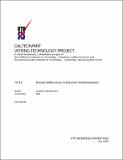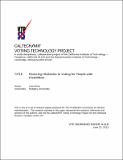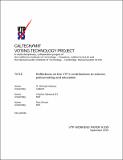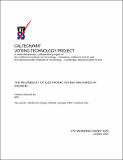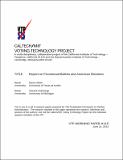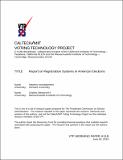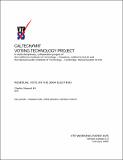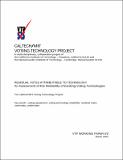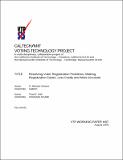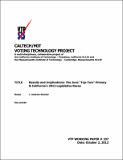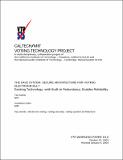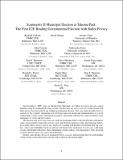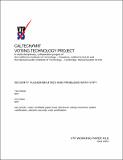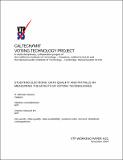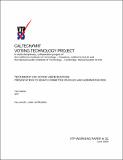Browsing Voting Technology Project by Title
Now showing items 75-94 of 125
-
Racial Differences in Election Administration
(Caltech/MIT Voting Technology Project, 2009-07-25) -
Rational and Pluralistic Approaches to HAVA Implementation
(Caltech/MIT Voting Technology Project, 2005-07)The Help America Vote Act (HAVA) has created a new dynamic for the oversight and implementation of federal elections, requiring states to assume greater control of election processes vis-a-vis their local governments than ... -
the Recruitment and Training of Poll Workers: What We Know from Scholarly Research
(Caltech/MIT Voting Technology Project, 2013-09-06)In every election an army of temporary poll workers must be recruited and trained to both assist the public in exercising the right to vote and to enforce the rules governing the voting process. These poll workers are ... -
Reducing Obstacles to Voting for People with Disabilities
(Caltech/MIT Voting Technology Project, 2013-06-22)The Presidential Commission on Election Administration’s mission includes identifying best practices and making recommendations to promote voting accessibility and improve the experiences of voters with disabilities. This ... -
Reflections on the VTP's contributions to science, policymaking and education
(Caltech/MIT Voting Technology Project, 2010-09)In the immediate wake of the 2000 presidential election, the Caltech/MIT Voting Technology Project was initiated. The initial and primary concern of the VTP at that moment was to understand the problems that arose in the ... -
The Reliability of Electronic Voting Machines in Georgia
(Caltech/MIT Voting Technology Project, 2004-10-08)Following the 2000 presidential election, the state of Georgia instituted the most comprehensive overhaul of voting technology in the country. Georgia’s actions, led by Secretary of State Cathy Cox, were precipitated by ... -
Report on Provisional Ballots and American Elections
(Caltech/MIT Voting Technology Project, 2013-06-21)Both empirical and anecdotal data indicate that the use of provisional ballots in U.S. elections is a mixed bag. On the one hand, providing voters whose eligibility is unclear with an opportunity to cast a provisional ... -
Report on Registration Systems in American Elections
(Caltech/MIT Voting Technology Project, 2013-06-26)Voter registration systems are the backbone of election administration in the United States today. These lists facilitate the operation of elections at the precinct level, communications by election officials and candidates ... -
Research Note on Footnote 24 of the 6th Circuit Hunter Decision
(Caltech/MIT Voting Technology Project, 2011-02-03)The decision issued by the three-judge panel of the 6th Circuit Court of Appeals in the matter of Hunter v. Hamilton County Board of Elections contains a very interesting analysis of problems with Ohio’s law about counting ... -
Residual Vote in the 2004 Election
(Caltech/MIT Voting Technology Project, 2005-02-07)In 2000 Americans learned that their elections are not always run according to the highest standards. This revelation led to two major developments. The first was a flurry of election reform activity at the state and ... -
Residual Votes Attributable to Technology: An Assessment of the Reliability of Existing Voting Equipment
(Caltech/MIT Voting Technology Project, 2001-03-30)American elections are conducted using a hodge-podge of different voting technologies: paper ballots, lever machines, punch cards, optically scanned ballots, and electronic machines. And the technologies we use change ... -
Resolving Voter Registration Problems: Making Registration Easier, Less Costly and More Accurate
(Caltech/MIT Voting Technology Project, 2009-08)The practice of voter registration has a long history in the United States. In 1800, Massachusetts was the first state to impose a voter registration requirement. By Reconstruction, voter registration was used in a handful ... -
Results and Implications: The June "Top-Two" Primary & California's 2012 Legislative Races
(Caltech/MIT Voting Technology Project, 2012-11-02)This report summarizes some basic results of California’s June 2012 “Top-Two” primary. It focuses on legislative offices with multiple districts within the state: California State Assembly, California State Senate, and ... -
The SAVE System: Secure Architecture for Voting Electronically: Existing Technology, with Built-in Redundancy, Enables Reliability
(Caltech/MIT Voting Technology Project, 2004-01-04)Existing technology is capable of yielding secure, reliable, and auditable voting systems. This system outlines an architecture based on redundancy at each stage of the ballot submission process that is resistant to external ... -
Scantegrity II Municipal Election at Takoma Park: The First E2E Binding Governmental Election with Ballot Privacy
(Caltech/MIT Voting Technology Project, 2010-02-01)On November 3, 2009, voters in Takoma Park, Maryland, cast ballots for mayor and city council members using the ScantegrityII voting system—the first time any end-to-end (e2e) voting system with ballot privacy has been ... -
Scantegrity Responds to Rice Study on Usability of the Scantegrity II Voting System
(Caltech/MIT Voting Technology Project, 2014-12-28)This note is a response to, and critique of, recent work by Acemyan, Kortum, Bryne, and Wallach regarding the usability of end-to-end verifiable voting systems, and in particular, to their analysis of the usability of the ... -
Security Vulnerabilities and Problems with VVPT
(Caltech/MIT Voting Technology Project, 2004-04)A proposed Voter Verifiable Paper Trail (VVPT) includes a printed ballot as a receipt that a voter can view to verify their vote before leaving an electronic voting machine. This method is also supposed to insure the ... -
Study Shows Ballot Design and Voter Preparation Could Have Eliminated Sarasota Florida Voting Errors
(Caltech/MIT Voting Technology Project, 2008-02-06)Election results showed extremely inconsistent voting rates for two high profile races in the Florida counties of Sarasota, Charlotte, and Sumter on November 7, 2006. The expected missing selections for these races were ... -
Studying Elections: Data Quality and Pitfalls in Measuring the Effects of Voting Technologies
(Caltech/MIT Voting Technology Project, 2004-11)Professor Geralyn Miller reminds us of the range of voting administration practices across the United States. We use this variability to study the average performance of various types of voting equipment throughout the ... -
Testimony on Voter Verification
(Caltech/MIT Voting Technology Project, 2005-06-21)In the past five years, following the 2000 Florida election fiasco, the voting technologies used in the United States have undergone a significant change. The use of direct recording electronic (DRE) voting machines has ...

